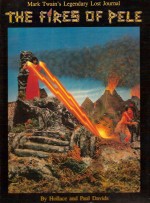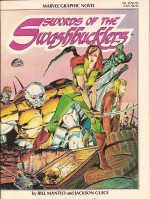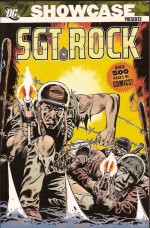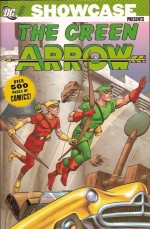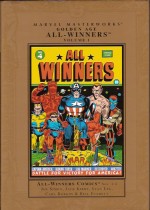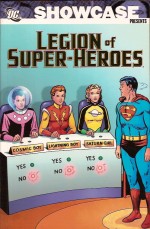
By Otto Binder, Jerry Siegel, Edmond Hamilton, Curt Swan, John Forte & various (DC Comics)
ISBN: 978-1- 4012-1382-4
Once upon a time, in the far future, a band of super-powered kids from dozens of alien civilisations took inspiration from the greatest legend of all time and formed a club of heroes. One day those Children of Tomorrow came back in time and invited that legend to join them…
And thus began the vast and epic saga of the Legion of Super-Heroes, as first envisioned by writer Otto Binder and artist Al Plastino in early 1958, just as the revived comicbook genre of superheroes was gathering an inexorable head of steam. Since that time the fortunes and popularity of the Legion have perpetually waxed and waned, with their future history tweaked and rebooted, retconned and overwritten again and again to comply with editorial diktat and popular whim.
This glorious, far-and-wide ranging monochrome collection assembles the many preliminary appearances of these valiant Tomorrow People and their inevitable progress towards and attainment of their own feature; including all pertinent material from Adventure Comics #247, 267, 282, 290, 293, and 300-321, Action Comics #267, 276, 287 and 289, Superboy #86, 89, 98, Superman #147, Superman Annual #4 and Superman’s Pal Jimmy Olsen #72 and 76.
The many-handed mob of juvenile universe-savers debuted in Adventure Comics #247 (April 1958) in a Superboy tale wherein three mysterious kids invited the Boy of Steel to the 30th century to join a team of metahuman champions all inspired by his historic career. Created by Otto Binder & Al Plastino, the throwaway concept inflamed public imagination and after a slew of further appearances throughout Superman Family titles, the LSH eventually took over Superboy’s lead spot in Adventure for their own far-flung, quirky escapades, with the Caped Kid Kryptonian reduced to “one of the in-crowdâ€â€¦
However here the excitement was still gradually building as the kids returned more than a 18 months later in Adventure #267 (December 1959) for Jerry Siegel & George Papp to play with. In ‘Prisoner of the Super-Heroes!‘ the teen wonders turned up to attack and incarcerate the Boy of Steel because of a misunderstood ancient record…
The following summer Supergirl met the Legion in Action Comics #267 (August 1960, by Siegel & Jim Mooney) as Lightning Lad, Saturn Girl and Cosmic Boy secretly travelled to “modern day†America to invite the Maid of Might to join the team, in a repetition of their offer to Superboy 15 years previously (in nit-picking fact they claimed to be the children of the original team – a fact glossed over and forgotten these days: don’t time-travel stories make your head hurt…?).
Due to a dubious technicality, young and eager Kara Zor-El failed her initiation at the hands of ‘The Three Super-Heroes’ and was asked to reapply later – but at least we got to meet a few more Legionnaires, including Chameleon Boy, Invisible Kid and Colossal Boy…
With the editors still cautiously testing the waters, it was Superboy #86 (January 1961) before the ‘The Army of Living Kryptonite Men!’ by Siegel & Papp turned the LSH into a last-minute Deus ex Machina to save the Smallville Sentinel from juvenile delinquent Lex Luthor’s most insidious assault. Two months later in Adventure #282, Binder & Papp introduced Star Boy as a romantic rival for the Krypton Kid in ‘Lana Lang and the Legion of Super-Heroes!’
Action #276 (May 1961) introduced ‘Supergirl’s Three Super Girl-Friends’ by Siegel & Mooney, which finally saw the her crack the plasti-glass ceiling and join the team, sponsored by Saturn Girl, Phantom Girl and Triplicate Girl. We also met for the first time Bouncing Boy, Shrinking Violet, Sun Boy and potential bad-boy love-interest Brainiac 5 (well at least his distant ancestor Brainiac was a very bad boy…)
Next comes a pivotal two-part tale ‘Superboy’s Big Brother’ (by Robert Bernstein & Papp from Superboy #89, June 1961) in which an amnesiac, super-powered space traveller crashes in Smallville, speaking Kryptonese and carrying star-maps written by the Boy of Steel’s long-dead father…
Jubilant, baffled and suspicious in equal amounts the Superboy eventually, tragically discovered ‘The Secret of Mon-El’ by accidentally exposing the stranger to a lingering, inexorable death, before desperately providing critical life-support by depositing the dying alien in the Phantom Zone until a cure could be found…
With an August 1961 cover-date Superman #147 unleashed ‘The Legion of Super-Villains’ (Siegel, Curt Swan & Sheldon Moldoff): a stand-out thriller featuring Lex Luthor and the adult Legion coming far too close to destroying the Action Ace until the temporal cavalry arrived…
Adventure #290 (November) by Bernstein & Papp seemingly gave Sun Boy a starring role in ‘The Secret of the Seventh Super-Hero!’ – a clever tale of redemption and second chances, followed in #293 (February 1962) by a gripping thriller from Siegel, Swan & George Klein: ‘The Legion of Super-Traitors’ wherein the future heroes were turned evil, prompting Saturn Girl to recruit a Legion of Super-Pets including Krypto, Streaky the Super Cat, Beppo, the monkey from Krypton and Comet the magical Super-horse to save the world – and yes, I typed all that with a reasonably straight face…
‘Supergirl’s Greatest Challenge!’ by Siegel & Mooney (Action #287 April 1962) saw her visit the Legion (quibblers be warned: for some reason it was mis-determined as the 21st century in this story) and saved future Earth from invasion. She also met a telepathic descendent of her cat Streaky. His name was Whizzy (I could have omitted that fact but chose not to – once more for smug, comedic effect and in sympathy with cat owners everywhere)…
Action #289 featured ‘Superman’s Super-Courtship!’ wherein the Girl of Steel scoured the universe for an ideal mate for her cousin. One highly possible candidate was the adult Saturn Woman, but her husband Lightning Man objected… Perhaps charming at the time, but modern sensibilities might quail at the conclusion that his perfect match was a doppelganger of Supergirl herself, but thankfully a bit older…
By the release of Superboy #98 (July 1962), the decision had been made. The buying public wanted more Legion stories and after ‘The Boy With Ultra-Powers’ by Siegel, Swan & Klein introduced a mysterious lad with greater powers than the Boy of Steel, focus shifted to Adventure Comics #300 (cover dated September 1962) where the futuristic super-squad finally landed their own gig; even occasionally taking an alternating cover-spot from the still top-featured Superboy.
Tales of the Legion of Super-Heroes opened its stellar run with ‘The Face Behind the Lead Mask!’ by Siegel, John Forte & Plastino; a fast-paced premier which pitted Superboy and the 30th century champions against an impossibly unbeatable foe until Mon-El, long-trapped in the Phantom Zone, briefly escaped a millennium of confinement and saved the day…
In those halcyon days humour was as important as action, imagination and drama, so many of the early exploits were light-hearted and moralistic. Issue #301 offered hope to fat kids everywhere with ‘The Secret Origin of Bouncing Boy!’ by regular creative team Siegel & Forte, wherein the process of open auditions was instigated (providing devoted fans with loads of truly bizarre and memorable applicants over the years) whilst allowing the rebounding human rotunda to give a salutary pep talk and inspirational recount of heroism persevering over adversity.
Adventure #302 featured ‘Sun Boy’s Lost Power!’ as the golden boy was forced to resign until fortune and boldness restored his abilities whilst ‘The Fantastic Spy!’ in #303 provided a tense tale of espionage and possible betrayal by new member Matter-Eater Lad.
The happy readership was stunned by the events of #304 when Saturn Girl engineered ‘The Stolen Super-Powers!’ to make herself a one-woman Legion. Of course it was for the best possible reasons, but still didn’t prevent the shocking murder of Lightning Lad…
With comfortable complacency utterly destroyed #305 further shook everything up with ‘The Secret of the Mystery Legionnaire!’ who turned out to be the long-suffering Mon-El finally cured and freed from his Phantom Zone prison.
Normally I’d try to be more obscure about story details – after all my intention is to get new people reading old comics – but these “spoiler†revelations are crucial to further understanding here and besides you all know these characters are still around, don’t you?
Pulp science fiction writer Edmond Hamilton took over the major scripting role with Adventure #306 and introduced ‘The Legion of Substitute Heroes!’ (still quirkily, perfectly illustrated by John Forte): a group of rejected applicants who selflessly banded together to clandestinely assist the champions who had spurned them, after which transmuting orphan Element Lad joined the team, seeking vengeance of the space pirates who had wiped out his entire species in ‘The Secret Power of the Mystery Super-Hero!’ and #308 seemingly saw ‘The Return of Lightning Lad!’
Spoiler Warning: skip to the next paragraph NOW!!! if you don’t want to know it was actually his similarly empowered sister who once unmasked – and unmanned – took her brother’s place as Lightning Lass…
‘The Legion of Super-Monsters!’ was a straightforward clash with embittered applicant Jungle King who took his rejection far too personally and gathered a deadly clutch of space beasts to wreak havoc and vengeance whilst ‘The Doom of the Super-Heroes!’ in #310 was a frantic battle for survival against an impossible foe and Adventure #311 saw ‘The War Between the Substitute Heroes and the Legionnaires!’ begin with a cease-and-desist order from the A-Team which turned into secret salvation as the plucky, stubborn outcasts carried on anyway under the very noses of the blithely oblivious LSH…
Issue #312 (September 1963) saw the ‘The Super-Sacrifice of the Legionnaires!’ and the inevitable resurrection of Lightning Lad – but only after the harrowing sacrifice of one devoted team-member – whilst in Superman’s Pal Jimmy Olsen #72 (October) ‘The World of Doomed Olsens!’ (Siegel, Swan & Klein) depicted an intriguing enigma wherein the cub-reporter was confronted by materialisations of his most memorable metamorphoses (see the Superman: the Amazing Transformations of Jimmy Olsen for further details), only to deduce it was all a prank by those naughty Legion scamps… but one with a serious purpose behind the jolly japery…
In #313’s ‘The Condemned Legionnaires!’ (Hamilton, Swan, Klein & Forte) Supergirl played a starring role when the mysterious Satan Girl infected the team with a deadly plague and forced them all into perpetual quarantine whilst ‘The Super-Villains of All Ages!’ (illustrated by Forte) had a manic mastermind steal a Legion Time-Bubble to recruit the greatest monsters and malcontents of history – Nero, Hitler and John Dillinger – as his irresistible army of crime.
Why he was surprised when they double-crossed him and took over the bodies of Superboy, Mon-El and Ultra Boy is beyond me… Happily, the lesser legionnaires still proved more a match for the brain-switched rogues.
‘The Legionnaires Super-Contest!’ in #315 finally saw the Substitute heroes go public, for which the primary team offered to allow one of them to join the big boys. Which one? That’s the contest part…
Issue #316’s ‘The Renegade Super-Hero!’ saw one trusted team-mate revealed as a career criminal and go on the run, but of course there was more to the tale than first appeared, after which the heroes were introduced to ‘The Menace of Dream Girl!’ a ravishing clairvoyant who beguiled her way into the Legion for her own obscure, arcane reasons. In her well-meaning way she presaged the coming of deadly threat The Time Trapper and also found a moment to convert the electrically redundant sister of the revived Lightning Lad into the gravity-defying Light Lass.
Adventure #318 featured ‘The Mutiny of the Legionnaires!’ wherein Sun Boy succumbed to battle fatigue and became a draconian Captain Bligh during an extended rescue mission, whilst in Superman’s Pal Jimmy Olsen #76 (April 1964) Siegel & Forte described ‘Elastic Lad Jimmy and his Legion Romances!’ wherein the plucky journalist was inveigled into the future and found himself inexplicably irresistible to the comely costumed champions of Tomorrow. It wasn’t his primitive charm, though…
Hamilton & Forte began a strong run of grittier tales from #319 on, beginning with ‘The Legion’s Suicide Squad!’ as the Science Police asked the team to destroy, at all costs, a monolithic space fortress, whilst #320 debuted a daring new character in Dev-Em, a forgotten survivor of Superman’s dead homeworld who was little more than a petty thug when Superboy first defeated him.
Now in ‘The Revenge of the Knave From Krypton!’ by Siegel, Forte, Papp, Moldoff & Plastino, the rapscallion returned as either a reformed undercover cop or the greatest traitor in history…
The story portion of this wonderful tome concludes with Adventure #321 and ‘The Code of the Legion!’ by Hamilton, Forte & Plastino which revealed the team’s underlying Articles of Procedure during a dire espionage flap, whilst testing one Legionnaire to the limits of his honour and ingenuity and actually ending another’s service forever.
Perhaps.
This is followed by an appropriate extra from Superman Annual #4 which featured a two-page informational guide illustrated and pictorial check-list of the team by Swan & Klein which was amended and supplemented in Adventure #316 with an additional two pages of stunning micro-pin-ups, all faithfully included here. This fabulously innocent and imaginative chronicle also includes every cover the team starred on: mostly the work of honorary Legionnaire Curt Swan and inkers George Klein, Stan Kaye, and Sheldon Moldoff.
The Legion is undoubtedly one of the most beloved and bewildering creations in American comicbook history and largely responsible for the growth of the groundswell movement that became Comics Fandom. Moreover, these sparkling, simplistic and devastatingly addictive stories as much as the legendary Julie Schwartz Justice League fired up the interest and imaginations of a generation of young readers and built the industry we all know today.
These naive, silly, joyous, stirring and utterly compelling yarns are precious and fun beyond any ability to explain – even if we old lags gently mock them to ourselves and one another. If you love comics and haven’t read this stuff, you are the poorer for it and need to enrich your future life as soon as possible.
© 1958-1964, 2007 DC Comics. All Rights Reserved.
